Often, it’s the little things that go unnoticed, but in the pursuit of tone perfection, even the diminutive and easily neglected pick can make a big difference. I must
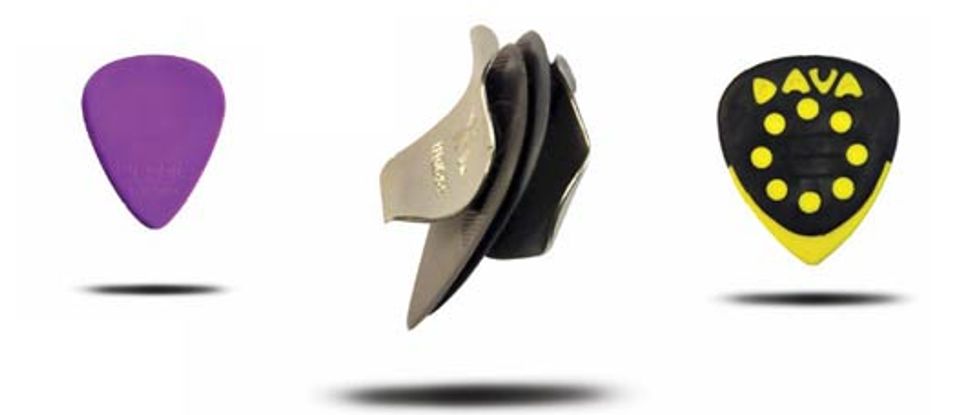
Often, it’s the little things that go unnoticed, but in the pursuit of tone perfection, even the diminutive and easily neglected pick can make a big difference. I must confess that I’ve been overlooking my own picks. When I buy them, I tend to grab a dozen or so of the same ones I bought the last time, stick a few in my mic stand pickholder, and forget about ‘em. So, when the PG staff was batting around the idea of a story on the plectrum, I saw my chance to get reacquainted with the tiny tool.
There are many factors to consider when hunting for the right pick: size, shape, thickness, flexibility, and material hardness, the edge, the point, and not least the grip. As with every other enterprise in the larger guitar industry, pick designs continue to be developed and refined; there are always new materials and expanded options. Since it’s high time I scouted some new picks, I took this opportunity to examine a handful of the many new options I’d been overlooking. I also talked to Jimmy Dunlop himself, to get the scoop on what I should keep an eye out for. And, since we at PG like to balance things out whenever we can, we also asked a fingerpicker for his take on playing without a pick. I suspect I’m not the only one who’s been taking the spectrum of plectrum for granted, so maybe this will help you in your own quest, too.
An Interview with Jimmy Dunlop
Chris Burgess: I want to thank you for talking to us about picks today. I just realized recently that I’ve mostly been using your picks since I started playing back in the eighties.
Jimmy Dunlop: I’ve pretty much dedicated my whole life to guitar picks (laughs).
Apparently, it’s still going okay for you…
Yeah, it’s going great. It’s an interesting business. A lot of people really underestimate guitar picks. When I meet people and they say, “What do you do for a living?” When I tell them I make guitar picks, they kind of give me that blank stare, but I equate what I do with making paintbrushes for artists. I’m like the guy that made Leonardo Da Vinci’s paintbrush. You know what I mean?
I got you. That’s not a bad place to be, is it?
No. And that’s why with guys like Santana and Jerry Garcia, and all the different people that have called me to design a special pick for them, I usually never charge for it, for the molding and all that. I just want to be able to say, “I did that for him.” It’s just because I want to be a part of that guy’s art in some way.
Does anybody ever call those guys and check to see whether or not they’re still using your picks?
Oh, well, no see… well… Jerry Garcia’s not using the picks anymore… but you know what happens with others, like Santana? They call up and they get the picks shipped to them, and they’ll buy 10,000 picks. Definitely, it’s the repeat business. That’s how we know.
Is there a lot that guitar players don’t know about the pick business? Something like an insider’s view, you know, on what’s changed, what’s still the same, and where things might be going?
Well, the one thing I don’t want to be doing is all of my competitors’ homework right now. This is my life, and it’s what I do, and if I have a couple little tricks that I use… It’s kind of like a guitar players set-up… they don’t tell you exactly what they’re really doing.
Fair enough. Another question I wanted to ask… there’s probably a whole generation of guitar players out there like me who’ve heard the legends of the tone of the tortoise shell pick, but have never played them, and we get um…
I have some. Wanna try one out?
I figured somebody had to have some somewhere. You know, I see advertisements for picks made out of materials that are supposed to imitate that, and I wonder if there’s a lot of truth to it, because I don’t really know… I guess that’s the question. Is it possible to really tell the difference that immediately?
Absolutely. One hundred percent, you can tell the difference.
What is the difference?
It’s a rigidity, and brightness. Tortoise shell picks are very rigid. They have a great memory, and they have a very bright tone. It’s funny, everybody’s searching for that sound. Well, obviously not everybody… every material has different molecular properties, different densities, and they’re all going to interact with the string differently. Do you know my Ultem material?
Yes.
The Ultex pick. When I first started playing around with that material about maybe eight years ago, we got some extruded Ultem in, and we punched it out, and it was very hard on our dyes. It had a little potato chip curve to it, because we had to pound the material and displace it so much that I really couldn’t get it to work right. But that sound, and the way that pick snaps, I think it emulates tortoise shell the best. I took it one step further. I worked with a friend of mine who was hip to all the different new polymers and plastics, and we bought new machinery, because it does melt at such high temperatures that standard machines like the ones we have here would be burned up in six months. The levels are so high when it flows correctly for a guitar pick. We actually had to buy machinery to be able to process that material. That’s how sold I was on the feel and the sound of Ultex.
Is there other stuff out there that’s kind of similar, or is that pretty much it?
That’s what I’m working with now. I mean, there are other guys who are using something, well I’m not exactly sure what … I think maybe an organic-based type material?
Something protein-based.
Right. I think that stuff sounds pretty good. It’s hard. I don’t know if it has the flexibility. I think with Ultem you really get the cool flexibility, and the memory. That’s what I’m going for.
I’m starting to put things together… there’s still so much to learn. Maybe a lot of players are like me… we’ve sort of been taking the pick for granted, you know?
I have the opportunity to work with the greatest guitar players of our time. Like I said, I equate what I do to making paintbrushes for artists, and there’s brushes for different strokes, and brushes for different landscapes, and you’ve got a fine brush, and you’ve got a wide brush… picks are the same way. You know, if you want a different tone, it starts with the pick. If you use a metallic pick, you’re going to interact with the strings differently; it’s going to be very bright, like a harsh sound. If you go for a celluloid pick, it’s going to be a soft tone. It’s a very soft pick, and it’s going to give you a more mellow tone.
I used to worry mostly about it being made out of something I could keep my fingers on when playing out. That’s become less of a problem for me over the years, but it’s still one of those habits. When I look around at picks that are available, I don’t think first about the tone I’m going to get, I think first about whether or not I’m going to be able to hold on to it.
Well you’re going to love this new pick I just came out with. I don’t know if you play with any nylon picks?
Actually, I do… the .88s.
Oh dude, you’re going to love the Max- Grip .88mms. It is like the ultimate grip on a nylon pick.
Sounds good to me. What I really like about the nylon picks is that you can quickly wear a really nice set of grooves in it, and really shape it to your grip. Not a lot of other picks do that as easily.
Yeah, that’s the flexibility and the memory.
How has the business of making and developing picks changed over the last few decades? Is that something you’re interested in?
I don’t know that the business has changed that much. We went through a period where we got involved with picks like the Strum Rose picks and picks that went beyond standard shapes and features. There’s a ton of different ideas for picks. I get calls once a week—actually, somebody else takes the calls now. Somebody always comes up with something… put it on a ring, do this, do that… but the standard pick shape, I love. It’s just that now there are so many new materials out there. It’s about trying to find the next Tortex, or the next Nylon, or the next Celluloid. For me, it’s got to be in materials.
The design itself is what’s lasted?
Yeah, I think the basic design, but there are also tips that can be changed, and other stuff. It all comes down to who you’re catering to. Gypsy jazz guys like those big 3 mm chunky picks, and then you get the rock ‘n’ rollers who like the .88s
You know, I was joking the other day with Joe Coffey, saying he could just cut up milk cartons because his picks are so thin. I’m not into them, but he really likes that flexibility. It seems like every guitar player has a different preference.
Thirty-one flavors, man. They did it with ice cream. I mean how many SKUs of picks do I have… a thousand? To find the right pick, you’ve got to just try out as many as you can. Research the guys that you look up to and aspire to sound like, and figure out what they’re using.
What if they’re using one of your pick designs that you’re not taking credit for, so you don’t know how to get a hold of ‘em?
(laughs) Then I’m out of luck, I guess… story of my life (Rodney Dangerfield routine) So has this been helpful?
Yes, extremely. I think our readers will appreciate it. Thank you again.
Yeah, you’re welcome.
Dava Picks
Dava’s Dave Story has been improving musicians’ tools for a long time, and he brings several good ideas together with these picks. He sent us a large variety, so I won’t go into detail about them all except to say that all are well-suited to their different purposes. Save for the Jazz Grips, all Dava Control picks feature a control region with an inserted molded tip. The control area allows you to easily change the flexibility of the pick by moving your grip, instead of loosening it. Different levels of flexibility in the same pick is highly useful. The inserted tips are also cool because you can get different kinds of tone and playability, but all the picks share the same grip.
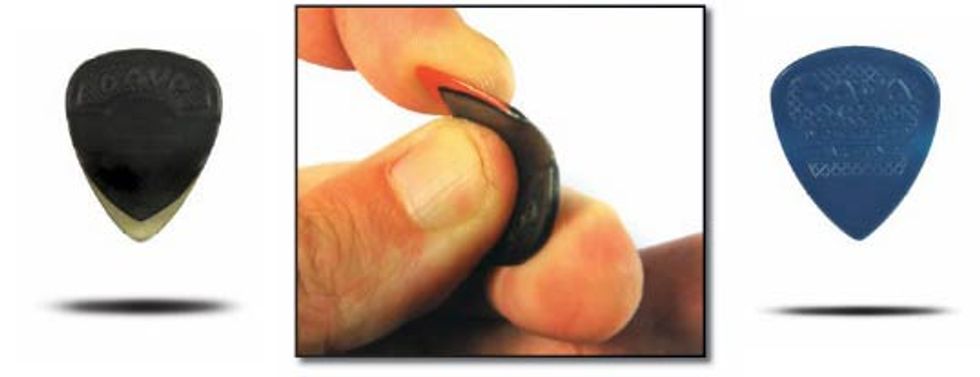
The Rock Control grips with 1mm celluloid tips are smooth and bright, the delrin are indeed fast, and the precision tip offers a sharp point. The nickel silvertipped Master Control picks are very bright, but also seem to get really good purchase on the strings. I liked the precision and clarity these tips brought to single-note lines.
Dava control nylons offer the same pliant feel and grip as standard nylons, but with Dava’s control region for a range of flexibility. Joe Coffey, who plays acoustic and electric rhythm guitar, reports that these have solved an old dilemma for him. He prefers the flexibility of very thin nylons, but they leave him without the mass and grip he needs for more dynamics and power. He been using these for a few weeks now, and I don’t think he’s looking back.
davapick.com
Surfpick
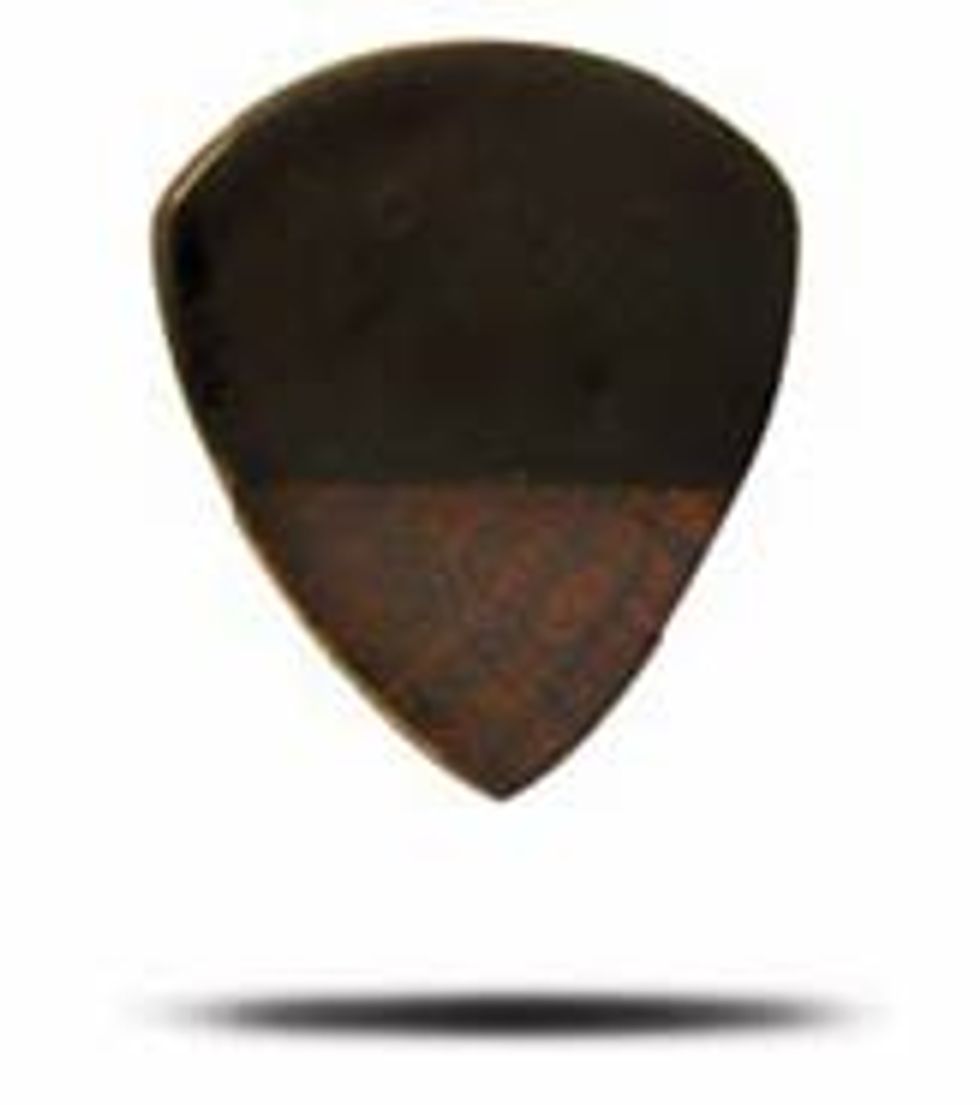 Ra Denney started making these picks from lignmum vitae, the densest wood on the Janka scale, but he now also offers picks made from Snakewood, which is slightly less dense but can be shipped internationally (it’s not on the CITES list). When it comes to presentation, these pull out all the stops—taking these handmade beauties out of their satin pouch produced subdued “oohs” and “ahhs” of appreciation all around. They play extremely well, too, and are far more comfortable and welcoming than I had anticipated. After a few weeks, it’s become hard think of a hardwood pick as an extravagance.
Ra Denney started making these picks from lignmum vitae, the densest wood on the Janka scale, but he now also offers picks made from Snakewood, which is slightly less dense but can be shipped internationally (it’s not on the CITES list). When it comes to presentation, these pull out all the stops—taking these handmade beauties out of their satin pouch produced subdued “oohs” and “ahhs” of appreciation all around. They play extremely well, too, and are far more comfortable and welcoming than I had anticipated. After a few weeks, it’s become hard think of a hardwood pick as an extravagance. 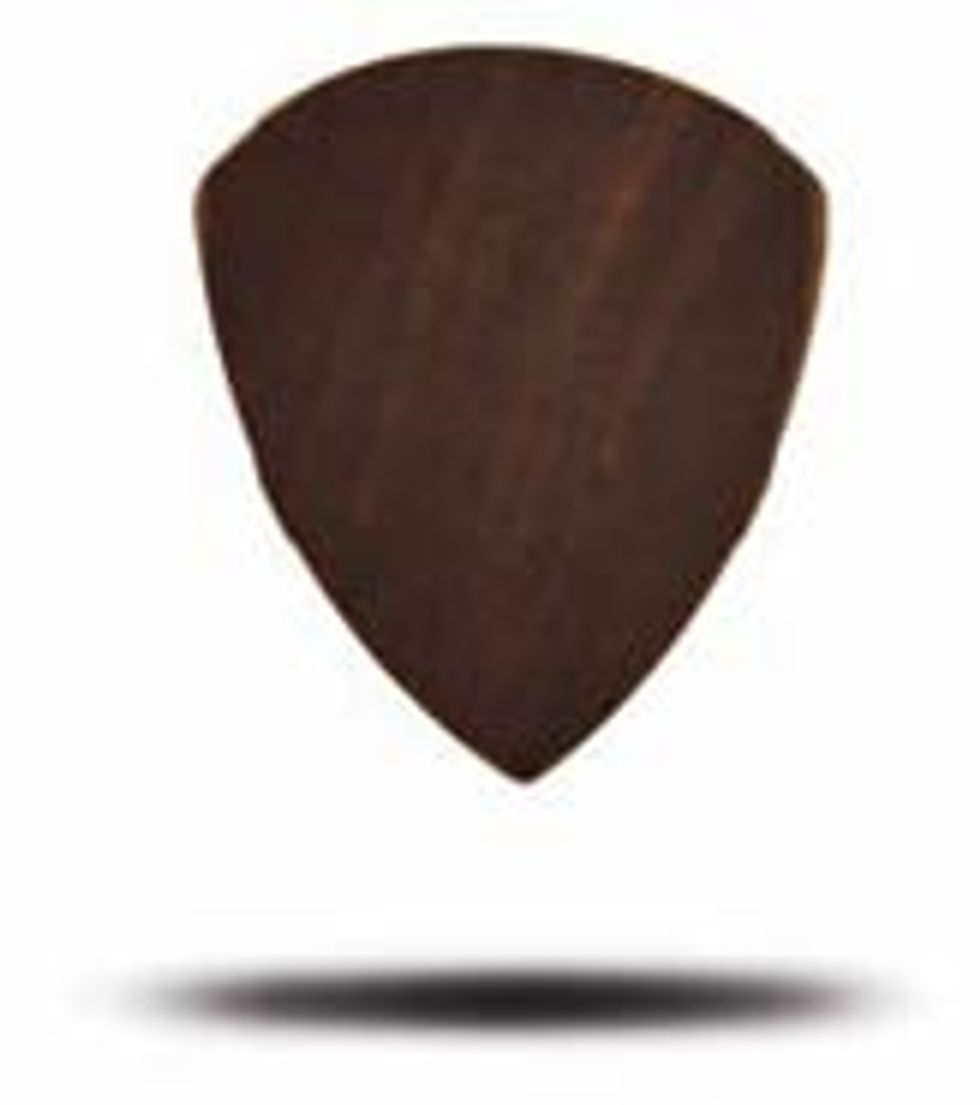 We tested a Rubber Grip Surfpick, a Jack Grassell holy bullet, and one of the new Snakewood Surfpicks. Each had a snug fit and enough mass to require very little force for a secure hold, letting me relax my grip a lot for strumming. Going from light runs to digging in was easy, too, since I didn’t need a death grip to keep from losing control of it. The Rubber Grip Surfpick has become my favorite of the three. The weight and thickness makes a smooth, clear attack easy. Denney will provide as sharp an edge as you prefer, and he’ll also replace your broken picks, but remember that wooden picks don’t flex, so don’t try to test them that way, or you’ll break them.
We tested a Rubber Grip Surfpick, a Jack Grassell holy bullet, and one of the new Snakewood Surfpicks. Each had a snug fit and enough mass to require very little force for a secure hold, letting me relax my grip a lot for strumming. Going from light runs to digging in was easy, too, since I didn’t need a death grip to keep from losing control of it. The Rubber Grip Surfpick has become my favorite of the three. The weight and thickness makes a smooth, clear attack easy. Denney will provide as sharp an edge as you prefer, and he’ll also replace your broken picks, but remember that wooden picks don’t flex, so don’t try to test them that way, or you’ll break them. surfpick.com
Big Rock Engineering
We got good selection of picks from Allen Chance with the X-1 ergonomic pick grips, which are stick-on, curved aluminum grips that will mount on just about any pick surface. It’s not complicated, but it does change the nature of your pick. These grips curve around your thumb and finger, requiring less force to get a good grip, which lets you relax your hand. It takes some getting used to, but it gives you control and dynamics without fatiquing tension. The X-1 does keep your finger and thumb from having much contact with the pick surface, so some techniques, like pinch harmonics, are out. Since the grip reinforces good technique, it does seem like it would be a very good practice pick for beginners and players who want increased accuracy.
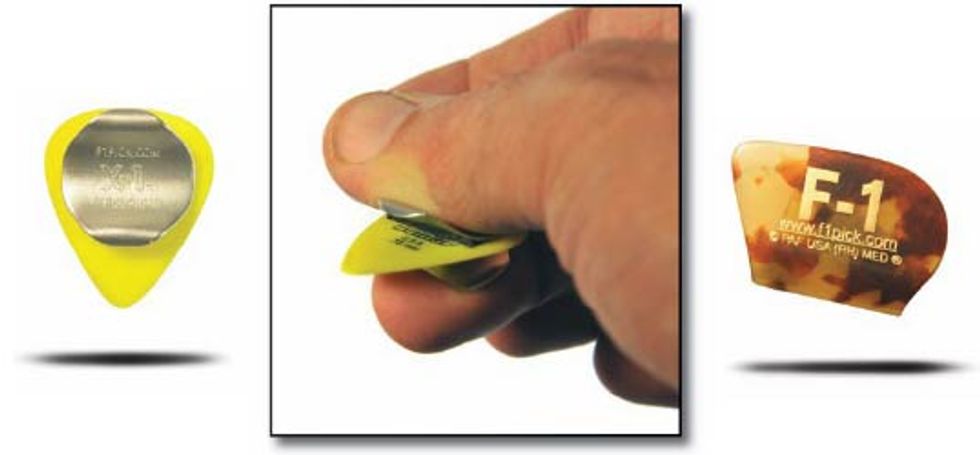
Big Rock also offers the F-1 ergonomic grip pick, which has a similar concept, but is made from a single piece of folded plastic that’s flat on the thumb side. The folded side curves around your finger, so it also takes less force to get a good grip.
bigrockeng.com
Dunlop Ultex
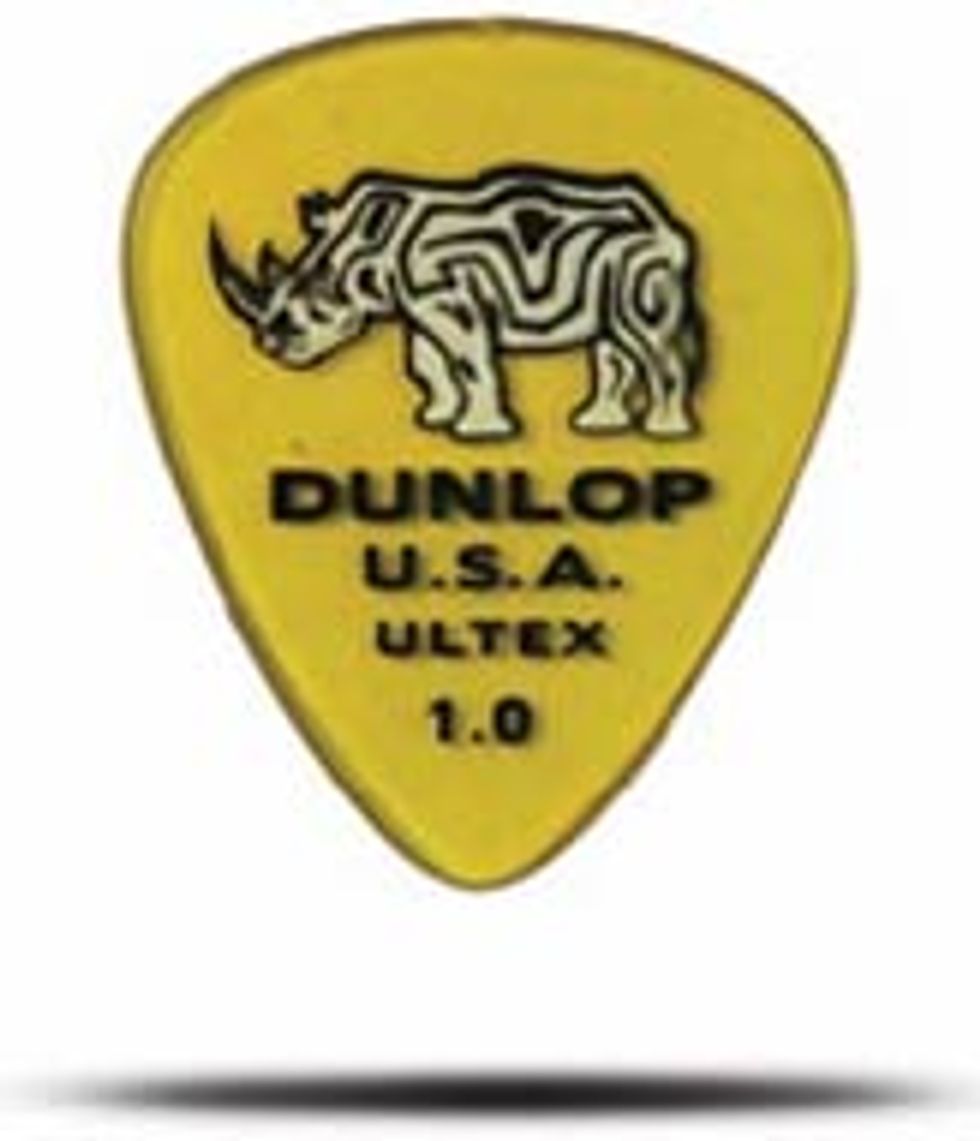 As I said, I have not been adventurous when it comes to pick selection, and have tended to stick to whatever’s been working. But since I’ve always liked the Dunlop nylon .88s and the tortex 1mm picks, I thought it would be a good idea to try the ultex picks. It turned out to be a very good idea. The ultem material is harder than a tortex pick of the same gauge, and much denser than the same gauge in nylon, but it’s still got flexibility—and even more of a snap. I like they way they feel, and the sound is brighter. They’re not hard to keep control of, despite the fact that they’re quite smooth. I’ve been finding myself going for the 1mm ultex picks a lot lately.
As I said, I have not been adventurous when it comes to pick selection, and have tended to stick to whatever’s been working. But since I’ve always liked the Dunlop nylon .88s and the tortex 1mm picks, I thought it would be a good idea to try the ultex picks. It turned out to be a very good idea. The ultem material is harder than a tortex pick of the same gauge, and much denser than the same gauge in nylon, but it’s still got flexibility—and even more of a snap. I like they way they feel, and the sound is brighter. They’re not hard to keep control of, despite the fact that they’re quite smooth. I’ve been finding myself going for the 1mm ultex picks a lot lately. jimdunlop.com
Red Bear Trading Co.
Dave Skowron’s New Tortis picks are handmade from a hard, protein-based material, and are designed to emulate the characteristics of real tortoise shell. They are very stiff and have no flex, but they are fast, smooths picks with a nice warm, bright tone. The click is really there. The polished surface feels different, glossier, than plastic varieties, but even though they’re not sticky I had no trouble keeping traction. You have to let go to drop one.
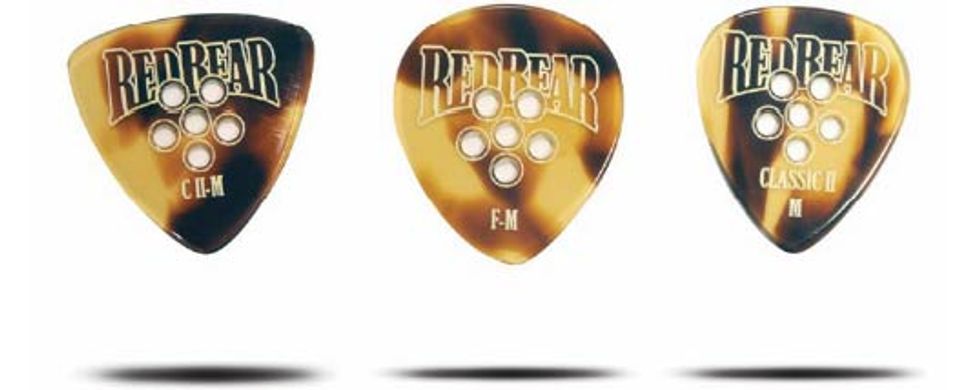
Since the picks are made from such hard material, Skowron creates the speed bevel himself (right-handed or left-handed). The density, feel and tone make them excellent for acoustic flatpicking, but they’ve been making me pretty happy on the electric as well. You might break one if you try to flex it, but it takes a lot of effort, so unless you’re a monster you’re not going to break it by playing. People around the PG offices really liked the look of the turtle shell with engraved Red Bear logo, but they’re offered in other colors, as well as a good selection of shapes and sizes.
redbeartrading.com
| A Fingerpicker’s Perspective by Lance Keltner I used to use a pick, in the mid-eighties. I found I was tucking that sucker into my palm and using my thumb and three fingers instead. It was an involuntary motion, not at all based on the style of music I was playing, as I was in a rock band in Texas, then played with Tim Karr (EMI) and Phil Lewis from L.A. Guns in the early nineties. Neither of these bands’ sonic landscapes would conjure up images of someone gently fingerpicking a classical guitar. How could such a bizarre (and seemingly wrong) change in technique take place by itself? I honestly couldn’t figure that out, but it felt great and actually sounded really good. I found I could control the dynamics of my tone with much more precision by using my fingers. If I was using a really touch-sensitive amp, the effect of playing sans pick was greatly magnified. My bass player Carmine and I were hanging out with a gang of New York players at China Club in the eighties when Jeff Beck showed up. He was a gracious, friendly guy who really didn’t want to talk guitars—more of a hot rod guy really—but he did indulge me for a moment before changing the subject to the thirties-era Ford street rod he was working on. Jeff’s hands look like two small war zones. They look like those of a dedicated mechanic (which he is), and several fingers look as if they’ve been mashed by auto parts (which they have). I asked him, “So why did you quit using a pick?” “Well you’re a singer, right?” he replied, “and you have a mic stand handy all of the time that you can put some tape on with some picks, right?” When I answered, “Yeah, I do,” he said, “Well I usually don’t and I would get sweaty and drop my pick and have to dig around in my pocket for another, so one day I just said to myself… Jeff, you can’t drop your finger, can you?” Just give it a try. Put the pick down for a second, or hide it in your palm. Experiment. Some players, like Beck, use their thumb a lot. I use my thumb for down strokes, and my fingers in an upward motion (think banjo player). You’ll notice if you work on it that your speed will increase and you’ll be able to play things that you just can’t pull off with a pick. I feel more attached to the rig when I’m sans pick. I get a tactile connection to the tubes and speakers that I just can’t muster with a piece of plastic between my fingers and the strings. You will tear up your fingers a bit in the beginning, until you get a comfortable technique. During one tour, I cut myself up so badly that I had my right hand taped up like a boxer for about four gigs. That hasn’t happened since I’ve figured out what works for me. It feels normal and natural now. Give it a try; you’ll find some tonal variations and some riffs in your hands that you didn’t know were there. |

